This was published 1 year ago
The controversial Olympic call that kickstarted modern timekeeping
A judge’s decision in a 1960 swimming final saw an Aussie win gold – and sounded the starting buzzer on the whiz-bang tech used at the Olympics today.
By Luke Benedictus
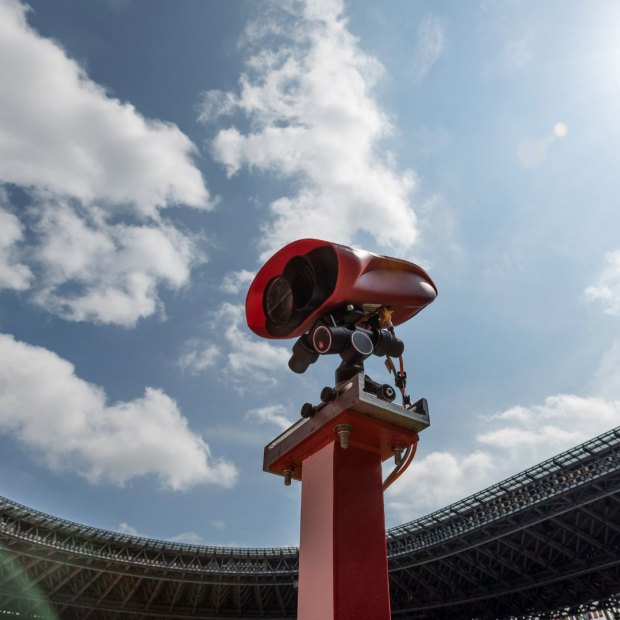
Omega’s finishing-line “Scan’O’Vision” camera can capture tens of thousands of images a second to determine the winner in close races.Credit: Courtesy of OMEGA
Alain Zobrist insists he isn’t worried and, to be fair, the CEO of Swiss Timing does look bafflingly relaxed. Heavily stubbled, he’s wearing a long-sleeved polo, ripped jeans and an amiable grin as he sits in a conference room at his company’s headquarters in Corgémont, a small town nestled in the Swiss Jura Mountains. Yet the Paris Olympics are looming, bringing with them a global TV audience of more than three billion to scrutinise his work. Surely he’s feeling some pressure? “Honestly, I sleep very well,” he says. “I have a fantastic team, and we trust the technology we deploy. If you can’t do that, you’re not ready.”
This calmness belies the complexity of Zobrist’s challenge: running the timekeeping, scoring and what the International Olympic Committee describes as “venue results systems and services” for the 2024 Paris Games. While the Swiss watch brand, Omega, is the official timekeeper of the Olympics, Swiss Timing – owned by parent company, Swatch Group –
develops the cutting-edge technology to make the job possible. In Paris, Zobrist’s team will oversee 329 events across 32 sports, from athletics to archery; breakdancing to BMX freestyle. And that’s before you get onto the Paralympics, which presents its own highly singular demands.
In order to manage all this, Zobrist is taking 550 timekeepers to Paris – along with more than 400 tonnes of equipment, specialised cameras, computers and 175 kilometres of cables and optical fibre. Ten days before the July 26 opening ceremony, this mountain of gear will be rigged up across 35
venues, double-checked, then readied for action.
The logistical magnitude of the task doesn’t make the possibility of a mistake any more palatable. At the Olympics, the difference between silver and gold can come down to the length of a fingernail. Zobrist’s team must deliver the technology to make those calls with absolute confidence. The 41-year-old acknowledges there is zero margin for error. “The worst thing that could happen at an Olympic event would be for there to be no time,” he concedes with a shudder. “Can you imagine having an athlete run a marathon and then telling them: ‘Sorry, please can you just run that again?’ ”
Luckily, Omega has clocked up plenty of experience at the Olympics, having taken the mantle of official timekeeper 30 times across the summer and winter games. It was first selected for the Los Angeles Olympics in 1932 due to the fact it was the only brand at the time with a stopwatch that could measure to one-tenth of a second. A lone watchmaker was duly dispatched from Omega’s head office in Biel with a suitcase full of 30 stopwatches for the judges to operate. Over the Games that followed, the technology quickly progressed. By the London Olympics in 1948, the company had developed a photo-finish camera and linked its stopwatches to the starting pistol for more accurate start times. But the Olympic Federation remained sceptical that electronic timing systems were more dependable than the human eye. “It needed a controversy to make the federation understand they had to change,” Zobrist says.
That controversy happened at the 1960 Rome Olympics in the 100 metres freestyle final. After the halfway turn, the great Australian swimmer, John Devitt, powered into the lead. But in the final 20 metres, Californian Lance Larson surged into contention until the two swimmers were separated, as The New York Times put it, by “the width of a flattened sardine”. Larson touched the wall underwater, Devitt’s arm struck above the surface. Who had actually won?
Back then, each lane had three dedicated timekeepers to measure the time of each competitor. The average of their three stopwatches decided a swimmer’s final time. Devitt was ruled to have finished in 0.55.20 seconds, while Larson’s time was 0.55.07. On that basis, the American had won gold. Yet with the margin of victory barely a nose-hair, the authorities were unwilling to let the instruments determine the result. Eventually, the chief judge, Hans Runstromer from Germany, was forced to step in. He decided that Devitt
deserved the gold and that both swimmers should be given the same time.
This bewildering call provoked outrage from the United States, but its four appeals were thrown out. As The New York Herald Tribune wrote after the race, “This required a Solomon, and the International Swimming Federation was fresh out of Solomons.”
Following the incident, the Olympic Committee finally recognised that electronic sensors were necessary to reduce the risk of human error. Omega’s response was to develop the first swimming “touch pads”. Introduced at the 1967 Pan-American Games, they revolutionised the accuracy of swimming results by enabling competitors to stop the clock by hitting the pads themselves.
“That was really the kickstart of modern timekeeping as we know it today,” says Zobrist. “Electronics are now everywhere, not only in swimming but in all different sports.” The innovation shows how the role of Olympic timekeeper extends way beyond turbo-charged stopwatches (although some of Omega’s “quantum timers” can measure to one-millionth of a second).
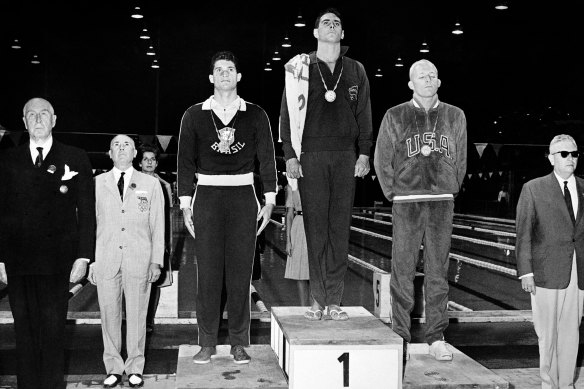
Australian John Devitt won gold in the 100 metres freestyle at the 1960 Rome Olympics in controversial circumstances, which led to a revolution in race timing systems.Credit: AFP
Yet as we walk around the Swiss Timing factory, Zobrist explains that his real challenge is to ensure every athlete gets a fair go. Down one long corridor, two lanes of a brick-red running track have been laid down over a 20-metre stretch and geared up with the same timing equipment used in Olympic track events. The electronic starting gun that Omega introduced in 2010 is a stylised weapon that looks more Buck Rogers than Dirty Harry. The former revolver-like pistol was replaced because the speed of sound proved too slow for elite runners – the pistol’s “bang” would be heard by an athlete on the outside lane fractionally later than a rival on the inside lane. On the track, those few milliseconds could change the entire trajectory of an athlete’s career. Now, when the trigger on the electronic starting gun is pulled, a pulse is sent to the electronic starting device, and a recording of a gunshot plays through speakers positioned behind each lane for equal sound distribution.
Each starting block, meanwhile, is equipped with an inbuilt, false-start detection system that works by measuring the physiological response time between the starting signal and the thrust of the athlete’s foot against the block.
Invited to try it, I crouch down and launch myself off the blocks at the sound of the gun. My reaction time, Zobrist tells me, was 345 milliseconds. “Usain Bolt’s would’ve been 120-130 milliseconds,” he says before gently conceding that Bolt wasn’t wearing brogues and a corduroy jacket.
Of the innovations Swiss Timing is bringing to Paris, Zobrist believes the biggest game-changer will be “computer vision technology”. In a studio just past the running track, he demonstrates how it works by performing a variety of stretches. His every action is filmed by multiple cameras that feed the data through an artificial intelligence system and onto a big screen, breaking down his body into a computerised skeletal image with green lines reflecting the slightest movement of each segmented limb.
The process we’re watching, he explains, is the next step in live-performance data. The AI capabilities of these multi-camera systems can track and analyse the exact movement of an athlete or the flight of, say, a shuttlecock or javelin. In the process, they allow a deep dive into the granular details of sporting performance. In a gymnastics floor routine, for example, the skeleton tracking can discern subtle details right down to the specific angles of a competitor’s feet during a jump rotation. In diving, using a combination of AI and mathematical algorithms, they can reproduce a 3D vision of each competitor’s efforts that will yield image data and metrics to calculate the milliseconds of airtime, speed of entry into the water and the precise gap between a diver’s body and the board.
‘We have to protect the integrity of the athletes’ results. That means we need to be absolutely neutral. Being Swiss helps.’
Alain Zobrist
These breakdowns offer a variety of benefits. They’ll enable judges to make even more informed decisions while also enhancing the TV viewing experience. Most significantly, the intel could help the competitors improve by furnishing them with feedback about every aspect of their performance.
Zobrist is also proud of an advancement called the “Scan’O’Vision Ultimate”, which he shows off in the room next door. Essentially, this is the next generation of photo-finish technology. Enhanced with the highest resolution of any photo-finish camera on the market, it can capture up to 40,000 digital images a second on the finish line of a race to produce a composite photo of every athlete at that climactic moment. Its purpose: to help judges determine the correct result by separating close finishes with maximum clarity and speed.
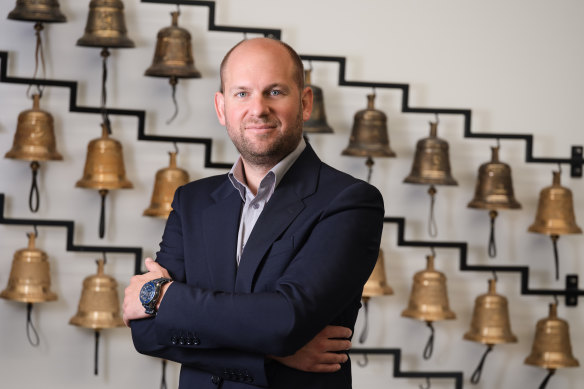
Alain Zobrist, CEO of Swiss Timing, says his challenge is to give all athletes a “fair go”.Credit: Courtesy of OMEGA
That timeliness in disseminating results is vital as Omega’s deal includes an end-to-end service delivery with the Olympic broadcasting services. Not only must it provide the technology to time and confirm results, it must also deliver software to format and transmit that data to a TV audience. Zobrist’s goal is to be able to confirm a time, produce a TV graphic and have it on screens within a tenth of a second. Furthermore, his team is committed to doing that in multiple languages, with each graphic simultaneously translated by AI from English into Chinese, Korean, Japanese, Russian, Arabic, Italian and French. “We try to be fast, but what’s even more important is precision,” he says.
Maintaining that precision requires Zobrist’s equipment to be able to cope with extreme swings in temperature, given its role extends to both the summer and winter Olympics. At the COVID-delayed Tokyo games, for example, Zobrist recalls the heat at the athletics track spiking to a brutal 44 degrees. Just eight months later, at the Winter Olympics in Beijing, temperatures plummeted to minus 34 degrees ahead of the downhill racing. Neither constituted any sort of problem. “We have a special chamber here where we expose all the equipment to between minus 40 degrees and plus 80 degrees,” Zobrist shrugs.
As our tour of the facility continues, the mind-bending scale of the work becomes clear as Zobrist talks through some of the bespoke challenges of the Paralympics. Take the high-tech solution to help partially blind athletes competing in the biathlon, a Winter Olympics event that involves cross-country skiing and rifle-shooting. How does a blind athlete shoot a target they can’t even see? The answer, Zobrist says, is by using a “special laser rifle” and a headset. The target sends out an infrared signal that is converted into an acoustic signal and the closer the shooter aims to the bullseye, the higher-pitched the frequency of the sound. “For the Paralympics, we just have to adapt our technology,” Zobrist admits. “But in the Olympics, every sport is unique. Every sport has different rules. Each one requires its own specific type of technology.”
Whether it’s speed-climbing or hammer-throwing, Zobrist’s mission is to maintain a level playing field for all. “Our values are accuracy, precision and fairness. We have no room for mistakes, and we have to protect the integrity of the athletes’ results. That means we need to be absolutely neutral,” he says. “Being Swiss helps.”
For all the efforts of Zobrist’s team, when the Olympics begin, there will be no mention of Swiss Timing. Instead, emblazoned on every timing device and starting pistol will be the name of the watch brand, Omega. “We’re sister companies,” explains Zobrist, although the relationship is rather more incestuous.
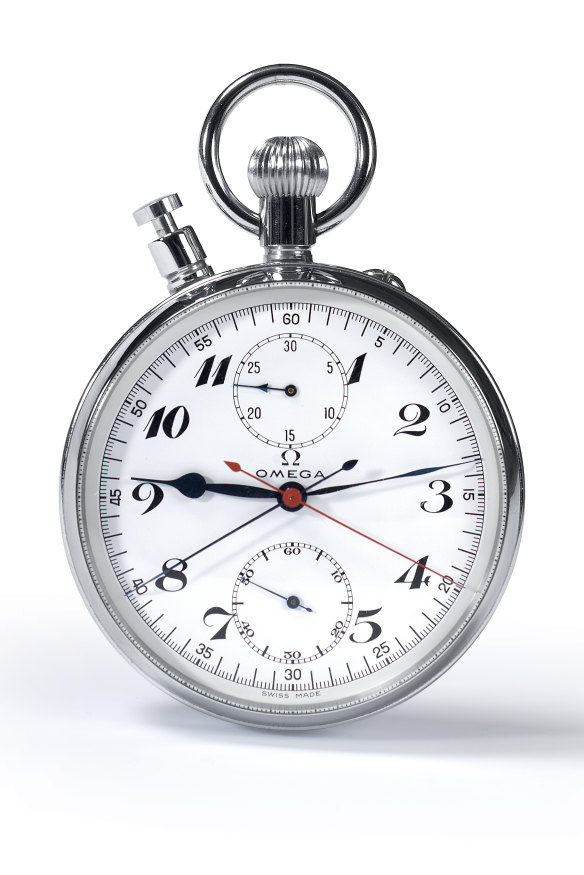
An Omega stopwatch used at the 1932 Los Angeles Olympics. At the time, it was the only stopwatch that could measure to one-tenth of a second.Credit: Courtesy of OMEGA
Omega’s sporting history stretches back to 1909, when it was named the official timekeeper at the world’s oldest balloon race, the Gordon Bennett Cup. But it was after the brand oversaw the 1932 Olympics that it ramped up its commitment, leading to the establishment of a specialist department, Omega Sports Timing. Meanwhile Longines, another watch brand owned by Swatch Group, was also involved in precision timekeeping. At the 1972 Munich Games, for example, Longines helped Omega to time various events including swimming, cycling, boxing and gymnastics. To consolidate these timekeeping divisions under one roof, Longines Timing merged with Omega Sports Timing in 1988 to become Swiss Timing. Subsequently, the Swatch Group positioned Omega as the public face of its Olympic timekeeping efforts to ensure one of its commercial brands would capitalise on the marketing exposure.
Yet while Omega gets the glory, it must also cop the public blame if anything goes wrong. To diminish the chances of any technical glitch, all the technology for each and every sport is field-tested through a progression of regional, national and international events before qualifying for Olympic consideration. At the Games themselves, Swiss Timing will maintain up to four back-up systems in Paris depending on the sport, run off an independent power source with multiple sets of emergency batteries on hand in case of failure, and operate their own computer network to offset any cybersecurity fears.
I still recall an exchange I had with Stephen Urquhart, the former Omega CEO. Ahead of the 2016 Rio Olympics, he insisted that the last thing he wanted was for his brand’s name to make the headlines. “If Omega is
mentioned,” he said, “There’s a good chance it’ll be related to a problem.”
At Omega’s headquarters, I put this concern to Raynald Aeschlimann. A dapper 54-year-old in a well-cut suit, the chief executive took over from Urquhart at Omega in 2016. “I agree; my predecessor was right,” Aeschlimann says. “We have a track record of zero mistakes, and we have to keep that.”
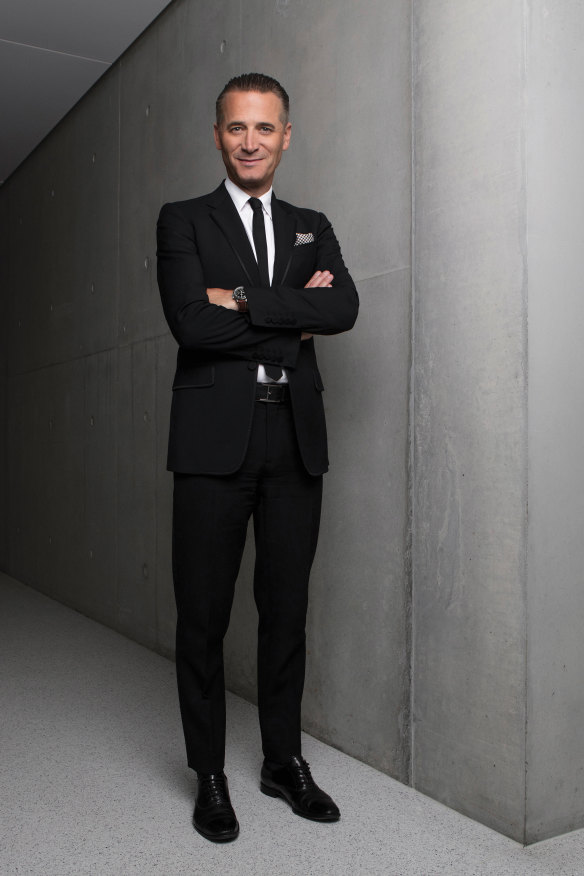
Omega CEO Raynald Aeschlimann says that without timekeeping expertise, “there would be no world records.”Credit: Courtesy of OMEGA
Why, then, does Omega willingly take on that colossal pressure? After all, if you want to bask in the reflected glory of a high-profile sporting event, there are plenty of others to choose from. Every fixture in the sporting calendar now has a dedicated watch sponsor, whether that’s Rolex at the Australian Open or Hublot at the FIFA World Cup. And their participation doesn’t seem to involve pumping untold sums into AI or photo-finish technology.
Sitting at a large marble table, Aeschlimann offers a patient smile. He admits the Olympics helps to reinforce Omega’s reputation for precision and innovation, but he’s at pains to point out that this is much more than a convoluted branding exercise. The Olympic Federation pays Omega a sizeable fee – which he won’t disclose – to provide timekeeping and results services to the athletes. Yet money isn’t the primary motivation, Aeschlimann insists.
What excites him is that Omega’s expertise has made it an integral part of the Olympic Games. “Without us,” he says, “There would be no world records.”
Then something unexpected happens. Aeschlimann pivots from his slick, executive patter and starts to reminisce. He tells me about his childhood growing up in the nearby town of Saint-Imier and how the Winter Olympics were such a momentous event for all the kids in the alpine region. “My parents were very strict and the only time we were ever allowed to eat in front of the television was during the skiing at the Olympic Games. I loved it!”
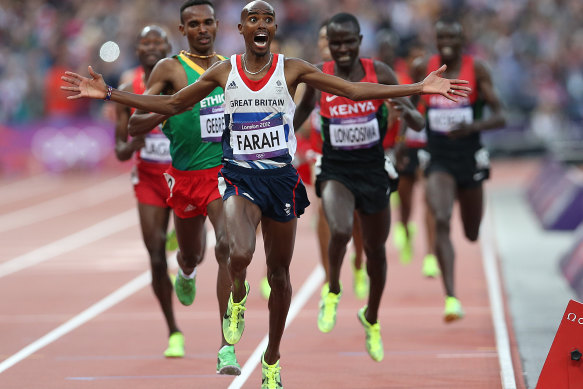
Great Britain’s Mo Farah wins gold in the 5000 metres in front of a home crowd at the London 2012 Olympics.Credit: Getty Images
Eyes widening, he goes on to regale me with the history of the ancient Olympic Games – “it dates back 800 years before Christ!” – and how this sporting event promoted harmony and peace because of the “Olympic Truce” in which rival Greek city-states would pause their conflicts to allow athletes safe passage to Olympia. Gaining momentum, he speaks of his first-hand experiences at the Games and recalls the awe-inspiring wall of sound he experienced at London’s Olympic Stadium in 2012 when Mo Farah – the Somalian turned British athlete – charged down the home straight to win gold in the 5000 metres final, cheered on by a delirious home crowd. “I’ll never forget it, the entire stadium, it was vibrating ...” Aeschlimann says. “I’m sorry, I’m getting emotional. But I love being of service to this event.”
And I’m not sure if this heartfelt speech is just a masterful sales pitch. But the truth is that some impassioned rhetoric and idealism are probably necessary to buy into the modern Olympics, dogged as they are by the same age-old problems from the billion-dollar costs the host city must bear to the inevitable doping scandals. Yet whatever your view of the Games, there’s something reassuring about the pathological rigour of the standards an Olympic timekeeper upholds. In a mistrustful world, rife with fake news and social-media baloney, that commitment to accuracy, fairness and objectivity feels more valuable than ever before.
To read more from Good Weekend magazine, visit our page at The Sydney Morning Herald, The Age and Brisbane Times.
correction
An earlier version of this story stated that British Olympian Mo Farah was a refugee. In 2022, Farah revealed he was a victim of child trafficking.